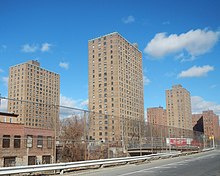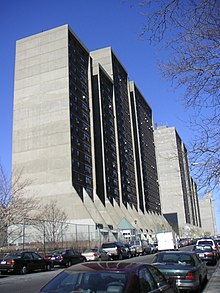Morrisania, Bronx
Morrisania | |
|---|---|
 Morris Houses, one of the many NYCHA public housing developments in the neighborhood | |
| Country | |
| State | |
| City | |
| Borough | File:Bronx Flag.jpg Bronx |
| Area | |
| • Total | 0.60 km2 (0.232 sq mi) |
| Population (2011)[1] | |
| • Total | 16,863 |
| • Density | 28,000/km2 (73,000/sq mi) |
| Economics | |
| • Median income | $21,545 |
| ZIP codes | 10456, 10459 |
| Area code | 718, 347, 646 |
Morrisania (/mɒr[invalid input: 'ɨ']ˈseɪniə/ morr-ə-SAY-nee-ə) is the historical name for the South Bronx in New York City, New York. The name derives from the powerful and aristocratic Morris family, who at one time owned all of the Manor of Morrisania as well as much of New Jersey. The family includes Lewis Morris, 4th Lord of the Manor, and a signer of the Declaration of Independence, and Gouverneur Morris, penman of the Constitution. They are buried in the crypt at St. Ann's Church of Morrisania.
Today the name is most commonly associated with the village of Morrisania, which is only a small corner of the original Morrisania. It is mostly a low income residential neighborhood geographically located in the southwestern Bronx. The neighborhood is part of Bronx Community Board 3. Its boundaries, starting from the north and moving clockwise are: the Cross-Bronx Expressway to the north, Crotona-Prospect Avenue to the east, East 161st Street to the south, and Webster Avenue to the west. Third Avenue is the primary thoroughfare through Morrisania. ZIP codes include 10456 and 10459. The area is patrolled by the NYPD's 42nd Precinct[2] located at 830 Washington Avenue. NYCHA property in the area is patrolled by P.S.A. 7 at 737 Melrose Avenue in the Melrose section of the Bronx.
Demographics
Morrisania is a low-income neighborhood with a population of around 16,863. The neighborhood predominantly consists of Latin Americans and African Americans. The vast majority of households are in public housing. Almost half of the population lives below the federal poverty line.[3][1]
Land use and terrain

Morrisania is dominated by public housing complexes of various types, vacant lots, and tenement buildings. Most of the original housing stock which consisted of older multi-unit homes and tenements were structurally damaged by arson and eventually razed by the city. The total land area is over a square mile. The terrain is somewhat hilly.
Morris High School Historic District
The landmarked Morris High School Historic District is north of the Forest Houses. The two square blocks between Boston Road, Forest Avenue, and East 166th Street have Morris High School and adjacent brownstones.[4][5]
Low income public housing projects


Twenty NYCHA developments are located in Morrisania.[6]
- 1162-1176 Washington Avenue; one rehabilitated 6-story tenement building.
- Butler Houses; six, 21-story buildings.
- Claremont Parkway-Franklin Avenue Area; three buildings, 3 and 7-stories tall.
- Davidson Houses; one 8-story building.
- Eagle Avenue-East 163rd Street; one 6-story building.
- Forest Houses; fifteen buildings, 9, 10 and 14-stories tall.
- Franklin Avenue I (Conventional); three rehabilitated tenement buildings, 5-stories tall.
- Franklin Avenue I M.H.O.P. (Multi Family Homeownership Program); two rehabilitated tenement buildings, 5-stories tall.
- Franklin Avenue II (Conventional); three rehabilitated tenement buildings, 5-stories tall.
- Franklin Avenue III (Conventional); one 5-story rehabilitated tenement building.
- Franklin Avenue III M.H.O.P. (Multi Family Homeownership Program); three rehabilitated tenement buildings, 5-stories tall.
- Jennings Street M.H.O.P. (Multi Family Homeownership Program); three rehabilitated tenement buildings, 5-stories tall.
- McKinley Houses; five, 16-story buildings.
- Morris I; ten buildings, 16 and 20-stories tall.
- Morris II; seven buildings, 16 and 20-stories tall.
- Morrisania Air Rights; two, 16-story buildings.
- PSS Grandparent; one 6-story building.
- Union Avenue-East 163rd Street; one nine-story building.
- Union Avenue-East 166th Street; six, 3-story buildings.
- Webster Houses; five, 21-story buildings.
History

From 1670, the land of the neighborhood was the estate of the Morris family in Westchester County. In 1790, Lewis Morris, owner of the estate and signer of the Declaration of Independence, proposed the land as the site of the federal capital.
The area was sparsely populated until 1840, when Gouverneur Morris Jr., son of the famous congressional delegate and nephew of Lewis, allowed a railroad to be built across the property. In 1848, he sold the land next to the line for the development of a new town called Morrisania Village. In 1855, additional settlements along the rail line became the town of Morrisania, with its political center in the original 1840 village.[7] At first the village was an early forerunner of today's bedroom communities, populated by people who worked in Manhattan, but it quickly developed its own local industries and craftsmen as it developed into a full-fledged town. In 1874, the area was annexed to New York City (then consisting only of Manhattan) as part of the Twenty-Third Ward. In 1887, the Third Avenue Elevated was extended to the area to provide easy and quick access to and from Manhattan. By the time the New York City Subway was extended to the area in 1904, a large influx of European immigrants had given the neighborhood an urban character, with tenements replacing houses as the dominant form of dwelling.[8][9]
In the 1950s along with changing demographics, Robert Moses destroyed various tenements in favor of a colony of public housing. After the construction of the Cross-Bronx Expressway, the poverty that East Tremont suffered spread into Morrisania. As a result, and also due to the aggressive 1968 Program for Action, the Third Avenue El closed in 1973. During this time period a wave of arson destroyed or damaged many of the residential, commercial, and industrial structures in the area.[10]
Many social problems associated with poverty, from crime to drug addiction, have plagued the area for some time. Despite crime declines versus their peaks during the crack and heroin epidemics, violent crime continues to be a serious problem in the community.[11] Morrisania has significantly higher drop-out rates and incidents of violence in its schools.[12] Other problems in local schools include low test scores and high truancy rates. Drug addiction is also a serious problem in the community. Due to the lucrative drug trade in the area, many addicts reside in the community. Peer pressure among children who come from broken homes contributes to the high rate of usage. Many households in the area are headed by a single mother, which contributes to the high poverty rate.[13] Single parent homes often have a harder time providing at the same level as two-parent homes. Many of the families living in Morrisania have been in poverty for generations. The incarceration rate in the area is also very high.[14] Morrisania is home to a significant number of inmates currently held in New York state prison and jail facilities.
After a wave of arson ravaged the low income communities of New York City throughout the 1970s, most of the residential structures in Morrisania were left seriously damaged or destroyed. The city began to rehabilitate many formally abandoned tenement style apartment buildings and designate them low income housing beginning in the late 1970s. Also many subsidized attached multi-unit townhouses and newly constructed apartment buildings have been or are being built on vacant lots across the neighborhood.
Education
Public schools include:
- PS 2/63: Morrisania (East 169th Street and Franklin Avenue)
- PS/MS 4: Crotona Park West (East 173rd Street and Fulton Avenue)
- PS 42: Claremont Village (Claremont Parkway and Washington Avenue)
- PS 35: Franz Siegel (East 163 Street and Grant Avenue)
- PS 88: Morrisania (Sheridan Ave and Marcy Place)
- PS 90: George Meany (McCellan and Sheridan Avenue)
- PS 55: Benjamin Franklin (St. Paul's Place and Washington Avenue)
- PS 110: Theodore Schoenfield (Crotona Park South and Fulton Avenue)
- PS 132: Garrett A. Morgan (East 168th Street and Washington Avenue)
- PS 140: Eagle (East 163rd Street and Eagle Avenue)
- PS 146: Edward "Pops" Collins (East 164th Street and Cauldwell Avenue)
- PS 186: Walter J. Damrosch Day Treatment Center (Jennings Street and Union Avenue)
- PS 198:(East 168th Street and Tinton Avenue)
- PS/MS 212: Theodore Gathings (Home Street and Union Avenue)
- PS 463-Urban Scholars Community School
- MS 128: Mott Hall III (St. Paul's Place and Washington Avenue) [occupying the 5th & 6th floor of the Benjamin Franklin School]
- MS 145: Arturo Toscanini (East 165th Street and Teller Avenue)
- MS 219: Charles Richard Drew (East 169th Street and Third Avenue)
- MS 301: Paul Laurence Dunbar (East 161st Street and Cauldwell Avenue)
- MS 313/339: Diana Sands (East 172nd Street and Webster Avenue)
- Morris High School (East 166th Street and Boston Road)
- Jane Addams High School (East 161st Street and Tinton Avenue)
- Bronx Center for Science and Mathematics (East 169th Street and Fulton Avenue)
- Eximius College Preparatory Academy (East 169th Street and Fulton Avenue)
- Bathgate High School Campus (Claremont Parkway and Bathgate Avenue)
- Success Academy Bronx 3, a K–2 charter school[15][16]
- The Eagle Academy for Young Men (East 176th Street and Third Avenue)
Transportation
- Bx6: to Hunt's Point or Riverside Drive (via 161st Street-163rd Street)
- Bx11: to Simpson Street (2 and 5) or George Washington Bridge Bus Terminal (via 170th Street)
- Bx15: to Fordham Plaza or Third Avenue–149th Street (2 and 5) (via Third Avenue)
- Bx15 LTD: to Fordham Plaza or West Harlem (via Third Avenue Limited)
- Bx21: to Westchester Square–East Tremont Avenue (6 and <6>) or Third Avenue–138th Street (6 and <6>) (via Boston Road–Morris Park Avenue)
- Bx35: to Simpson Street (2 and 5) or George Washington Bridge Bus Terminal (via 167th Street)
- Bx41 and Bx41 SBS: to Gun Hill Road (2 and 5) or Third Avenue–149th Street (2 and 5) (via Webster Avenue)
Notable people
- Edward Stanley Kellogg, 16th Governor of American Samoa, was born in Morrisania.
- Rapper Cuban Link was raised on Prospect Avenue in Morrisania.
- Lewis Morris, signed the United States Declaration of Independence.[17]
- Doo-wop group The Wrens were raised in Morrisania and attended Morris High School (where they formed the group)
References
- ^ a b c "Morrisania neighborhood in New York". Retrieved August 12, 2015.
- ^ "42nd Precinct". Retrieved 24 November 2015.
- ^ Bronx Community District 3
- ^ Morris High School Historic District
- ^ "Morris High School Historic District Designation Report" (PDF). Retrieved 15 September 2015.
- ^ NYCHA
- ^ "History of the Bronx". Retrieved 24 November 2015.
- ^ "Bronx History - Early European Residents". Retrieved 24 November 2015.
- ^ "Bronx History - Birth of A Borough". Retrieved 24 November 2015.
- ^ "Bronx History - Growth and Urbanization". Retrieved 24 November 2015.
- ^ 42nd Precinct CompStat Report
- ^ NYC Dropout Rates
- ^ Bronx Census Data Analysis
- ^ NYC Prison Expenditure
- ^ "Public Hearing Summary (State Univ. of N.Y., Charter Schools Institute) for "Charter School" "Success Academy Charter School – Bronx 3" (PDF). Retrieved 12 August 2015.
- ^ "Success Academy Bronx 3 (Success Academy Charter Schools) (official website)". Retrieved 12 August 2015.
- ^ "Lewis Morris". UShistory.org. Retrieved August 2015.
{{cite web}}: Check date values in:|accessdate=(help)

